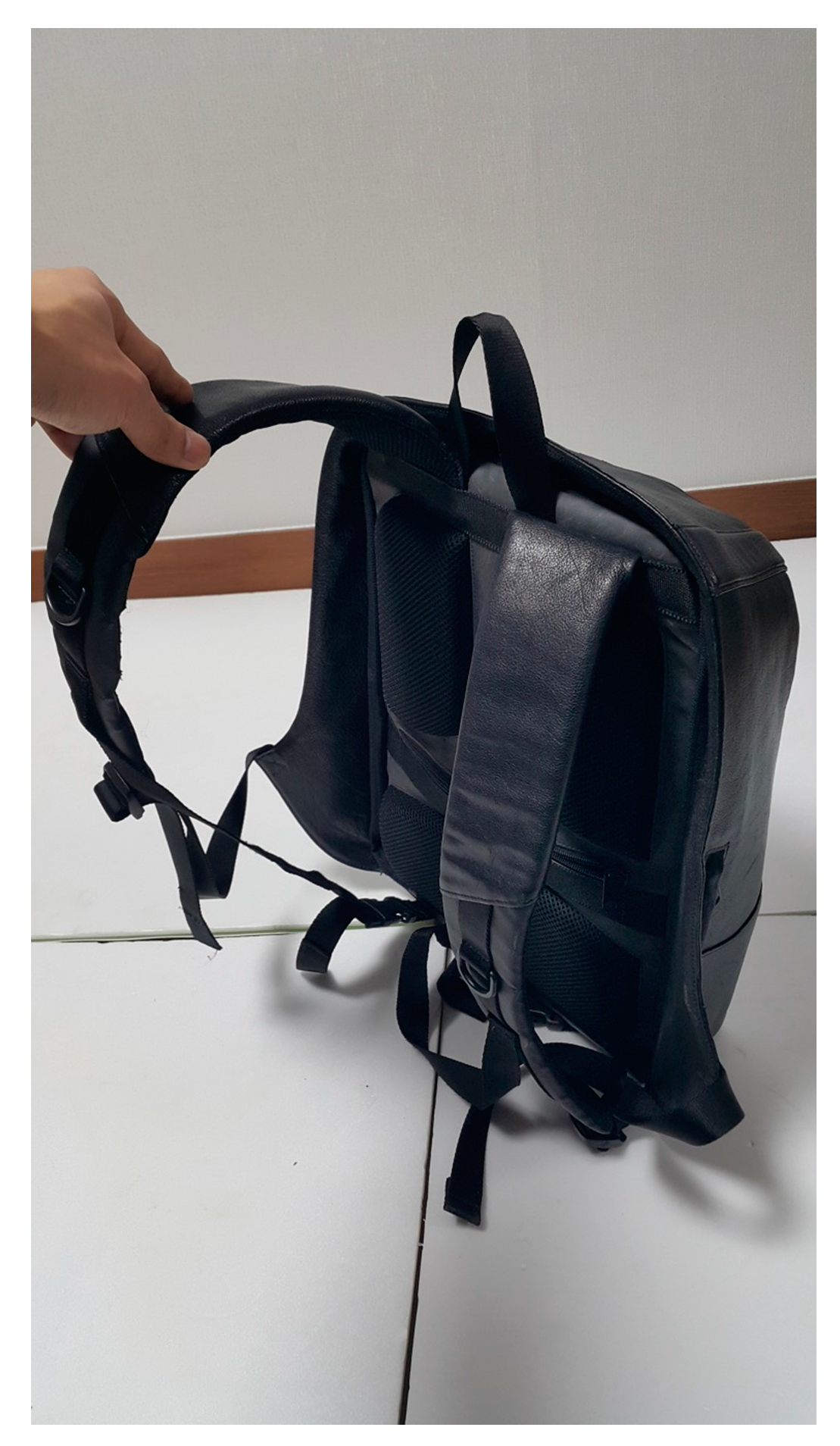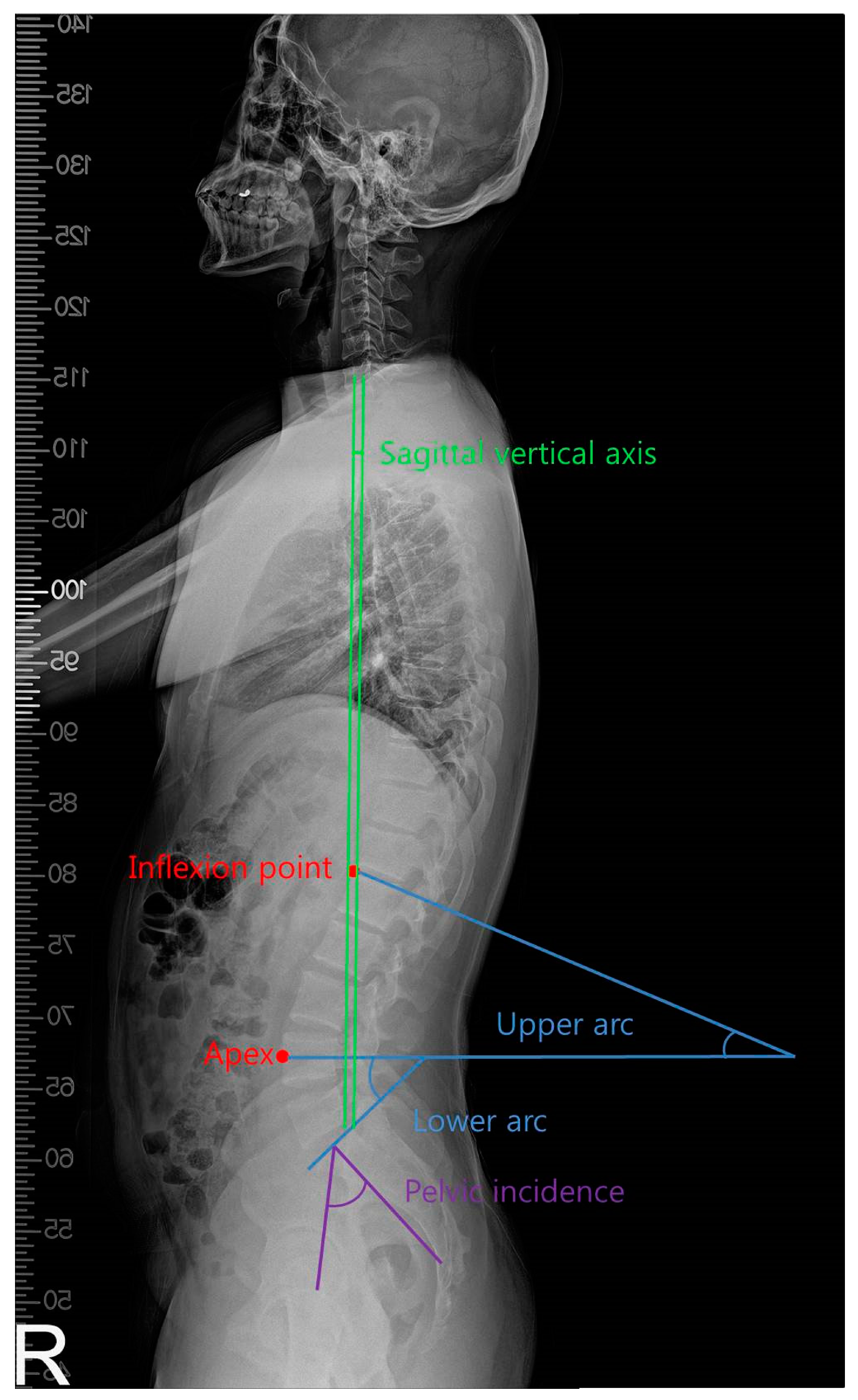Analysis of the Effect of Backpack Design with Reduced Load Moment Arm on Spinal Alignment
Abstract
1. Introduction
2. Materials and Methods
2.1. Subjects
2.2. Protocol
2.3. Measurement
2.4. Statistical Methods
3. Results
3.1. General Characteristics of Subjects
3.2. Comparison of Cervical Spine Alignment
3.3. Comparison of Lumbar Spine Alignment
3.4. Comparison of Differences between Pelvic Incidence and Lumbar Lordosis
3.5. Comparison of Sagittal Vertical Axis
4. Discussion
5. Conclusions
Author Contributions
Funding
Conflicts of Interest
References
- Kang, J.H.; Park, R.Y.; Lee, S.J.; Kim, J.Y.; Yoon, S.R.; Jung, K.I. The effect of the forward head posture on postural balance in long time computer based worker. Ann. Rehabil. Med. 2012, 36, 98–104. [Google Scholar] [CrossRef] [PubMed]
- Roussouly, P.; Gollogly, S.; Berthonnaud, E.; Dimnet, J. Classification of the normal variation in the sagittal alignment of the human lumbar spine and pelvis in the standing position. Spine (Phila Pa 1976) 2005, 30, 346–353. [Google Scholar] [CrossRef] [PubMed]
- Glassman, S.D.; Bridwell, K.; Dimar, J.R.; Horton, W.; Berven, S.; Schwab, F. The impact of positive sagittal balance in adult spinal deformity. Spine (Phila Pa 1976) 2005, 30, 2024–2029. [Google Scholar] [CrossRef] [PubMed]
- Lee, S.H.; Son, E.S.; Seo, E.M.; Suk, K.S.; Kim, K.T. Factors determining cervical spine sagittal balance in asymptomatic adults: Correlation with spinopelvic balance and thoracic inlet alignment. Spine J. 2015, 15, 705–712. [Google Scholar] [CrossRef]
- Laouissat, F.; Sebaaly, A.; Gehrchen, M.; Roussouly, P. Classification of normal sagittal spine alignment: Refounding the Roussouly classification. Eur. Spine J. 2018, 27, 2002–2011. [Google Scholar] [CrossRef]
- Barbieri, D.F.; Srinivasan, D.; Mathiassen, S.E.; Oliveira, A.B. Variation in upper extremity, neck and trunk postures when performing computer work at a sit-stand station. Appl. Ergon. 2019, 75, 120–128. [Google Scholar] [CrossRef]
- Orloff, H.A.; Rapp, C.M. The effects of load carriage on spinal curvature and posture. Spine (Phila Pa 1976) 2004, 29, 1325–1329. [Google Scholar] [CrossRef]
- Brackley, H.M.; Stevenson, J.M.; Selinger, J.C. Effect of backpack load placement on posture and spinal curvature in prepubescent children. Work 2009, 32, 351–360. [Google Scholar]
- Chow, D.H.; Leung, K.T.; Holmes, A.D. Changes in spinal curvature and proprioception of schoolboys carrying different weights of backpack. Ergonomics 2007, 50, 2148–2156. [Google Scholar] [CrossRef]
- Li, S.S.; Chow, D.H. Multi-objective analysis for assessing simultaneous changes in regional spinal curvatures under backpack carriage in young adults. Ergonomics 2016, 59, 1494–1504. [Google Scholar] [CrossRef]
- Neuschwander, T.B.; Cutrone, J.; Macias, B.R.; Cutrone, S.; Murthy, G.; Chambers, H.; Hargens, A.R. The effect of backpacks on the lumbar spine in children: A standing magnetic resonance imaging study. Spine (Phila Pa 1976) 2010, 35, 83–88. [Google Scholar] [CrossRef] [PubMed]
- Brackley, H.M.; Stevenson, J.M. Are children’s backpack weight limits enough? A critical review of the relevant literature. Spine (Phila Pa 1976) 2004, 29, 2184–2190. [Google Scholar] [CrossRef] [PubMed]
- Iyer, S.R. An ergonomic study of chronic musculoskeletal pain in schoolchildren. Indian J. Pediatr. 2001, 68, 937–941. [Google Scholar] [CrossRef] [PubMed]
- Drzal-Grabiec, J.; Snela, S.; Rachwal, M.; Podgorska, J.; Rykala, J. Effects of carrying a backpack in an asymmetrical manner on the asymmetries of the trunk and parameters defining lateral flexion of the spine. Hum. Factors 2015, 57, 218–226. [Google Scholar] [CrossRef] [PubMed]
- Schwab, F.J.; Blondel, B.; Bess, S.; Hostin, R.; Shaffrey, C.I.; Smith, J.S.; Boachie-Adjei, O.; Burton, D.C.; Akbarnia, B.A.; Mundis, G.M.; et al. Radiographical spinopelvic parameters and disability in the setting of adult spinal deformity: A prospective multicenter analysis. Spine (Phila Pa 1976) 2013, 38, E803–E812. [Google Scholar] [CrossRef] [PubMed]
- Harrison, D.E.; Harrison, D.D.; Cailliet, R.; Troyanovich, S.J.; Janik, T.J.; Holland, B. Cobb method or Harrison posterior tangent method: Which to choose for lateral cervical radiographic analysis. Spine (Phila Pa 1976) 2000, 25, 2072–2078. [Google Scholar] [CrossRef]
- Sun, A.; Yeo, H.G.; Kim, T.U.; Hyun, J.K.; Kim, J.Y. Radiologic assessment of forward head posture and its relation to myofascial pain syndrome. Ann. Rehabil. Med. 2014, 38, 821–826. [Google Scholar] [CrossRef]
- McClendon, J.; Graham, R.B.; Sugrue, P.A.; Smith, T.R.; Thompson, S.E.; Koski, T.R. Cranial Center of Mass Compared to C7 Plumb Line Alignment in Adult Spinal Deformity. World Neurosurg. 2016, 91, 199–204. [Google Scholar] [CrossRef]
- Korovessis, P.; Koureas, G.; Papazisis, Z. Correlation between backpack weight and way of carrying, sagittal and frontal spinal curvatures, athletic activity, and dorsal and low back pain in schoolchildren and adolescents. J. Spinal Disord. Tech. 2004, 17, 33–40. [Google Scholar] [CrossRef]
- Chaleat-Valayer, E.; Mac-Thiong, J.M.; Paquet, J.; Berthonnaud, E.; Siani, F.; Roussouly, P. Sagittal spino-pelvic alignment in chronic low back pain. Eur. Spine J. 2011, 20 (Suppl. 5), 634–640. [Google Scholar] [CrossRef]
- Lee, C.S.; Chung, S.S.; Kang, K.C.; Park, S.J.; Shin, S.K. Normal patterns of sagittal alignment of the spine in young adults radiological analysis in a Korean population. Spine (Phila Pa 1976) 2011, 36, E1648–E1654. [Google Scholar] [CrossRef] [PubMed]
- Schwab, F.; Lafage, V.; Patel, A.; Farcy, J.P. Sagittal plane considerations and the pelvis in the adult patient. Spine (Phila Pa 1976) 2009, 34, 1828–1833. [Google Scholar] [CrossRef] [PubMed]
- Berthonnaud, E.; Dimnet, J.; Roussouly, P.; Labelle, H. Analysis of the sagittal balance of the spine and pelvis using shape and orientation parameters. J. Spinal Disord. Tech. 2005, 18, 40–47. [Google Scholar] [CrossRef] [PubMed]
- Bernhardt, M.; Bridwell, K.H. Segmental analysis of the sagittal plane alignment of the normal thoracic and lumbar spines and thoracolumbar junction. Spine (Phila Pa 1976) 1989, 14, 717–721. [Google Scholar] [CrossRef] [PubMed]
- Cho, K.J.; Kim, K.T.; Kim, W.J.; Lee, S.H.; Jung, J.H.; Kim, Y.T.; Park, H.B. Pedicle subtraction osteotomy in elderly patients with degenerative sagittal imbalance. Spine (Phila Pa 1976) 2013, 38, E1561–E1566. [Google Scholar] [CrossRef]
- Kumar, M.N.; Baklanov, A.; Chopin, D. Correlation between sagittal plane changes and adjacent segment degeneration following lumbar spine fusion. Eur. Spine J. 2001, 10, 314–319. [Google Scholar] [CrossRef]
- Nojiri, K.; Matsumoto, M.; Chiba, K.; Maruiwa, H.; Nakamura, M.; Nishizawa, T.; Toyama, Y. Relationship between alignment of upper and lower cervical spine in asymptomatic individuals. J. Neurosurg. 2003, 99, 80–83. [Google Scholar] [CrossRef]
- Treaster, D.; Marras, W.S.; Burr, D.; Sheedy, J.E.; Hart, D. Myofascial trigger point development from visual and postural stressors during computer work. J. Electromyogr. Kinesiol. 2006, 16, 115–124. [Google Scholar] [CrossRef]
- Chiou, W.K.; Chou, W.Y.; Chen, B.H. Notebook computer use with different monitor tilt angle: Effects on posture, muscle activity and discomfort of neck pain users. Work 2012, 41 (Suppl. 1), 2591–2595. [Google Scholar]
- Yip, C.H.; Chiu, T.T.; Poon, A.T. The relationship between head posture and severity and disability of patients with neck pain. Man. Ther. 2008, 13, 148–154. [Google Scholar] [CrossRef]



| Parameter | WB | NB | RB | F | p |
|---|---|---|---|---|---|
| Cervical (degree) | 11.4 ± 7.9 | 6.6 ± 4.5 * | 6.5 ± 5.2 * | 4.649 | 0.016 |
| Parameter | WB | NB | RB | F | p |
|---|---|---|---|---|---|
| Whole arc (degree) | 49.0 ± 6.6 # | 44.0 ± 8.3 *,† | 47.6 ± 9.8 # | 5.583 | 0.008 |
| Upper arc (degree) | 9.3 ± 4.6 | 8.6 ± 3.4 | 8.5 ± 3.9 | 0.442 | 0.646 |
| Lower arc (degree) | 39.7 ± 3.2 # | 35.3 ± 5.8 *,† | 39.1 ± 7.8 # | 6.783 | 0.003 |
| Parameter | WB | NB | RB | F | p |
|---|---|---|---|---|---|
| Differences (degree) | 10.0 ± 9.4 # | 13.7 ± 9.0 * | 12.0 ± 9.2 | 3.307 | 0.049 |
| Parameter | WB | NB | RB | F | p |
|---|---|---|---|---|---|
| SVA (mm) | 25.2 ± 16.8 # | 49.3 ± 16.1 *,† | 46.9 ± 11.2 # | 10.837 | 0.001 |
© 2019 by the authors. Licensee MDPI, Basel, Switzerland. This article is an open access article distributed under the terms and conditions of the Creative Commons Attribution (CC BY) license (http://creativecommons.org/licenses/by/4.0/).
Share and Cite
Kim, K.-h.; Ann, J.; Jang, S.-h. Analysis of the Effect of Backpack Design with Reduced Load Moment Arm on Spinal Alignment. Int. J. Environ. Res. Public Health 2019, 16, 4351. https://doi.org/10.3390/ijerph16224351
Kim K-h, Ann J, Jang S-h. Analysis of the Effect of Backpack Design with Reduced Load Moment Arm on Spinal Alignment. International Journal of Environmental Research and Public Health. 2019; 16(22):4351. https://doi.org/10.3390/ijerph16224351
Chicago/Turabian StyleKim, Kyung-hun, Jihyeon Ann, and Sang-hun Jang. 2019. "Analysis of the Effect of Backpack Design with Reduced Load Moment Arm on Spinal Alignment" International Journal of Environmental Research and Public Health 16, no. 22: 4351. https://doi.org/10.3390/ijerph16224351
APA StyleKim, K.-h., Ann, J., & Jang, S.-h. (2019). Analysis of the Effect of Backpack Design with Reduced Load Moment Arm on Spinal Alignment. International Journal of Environmental Research and Public Health, 16(22), 4351. https://doi.org/10.3390/ijerph16224351




